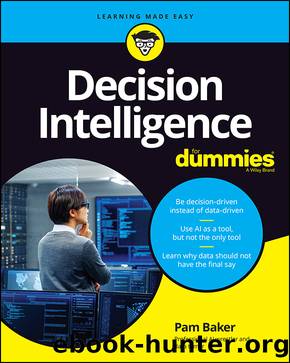Decision Intelligence For Dummies by Pamela Baker

Author:Pamela Baker [Baker, Pam]
Language: eng
Format: epub
ISBN: 9781119824862
Publisher: Wiley
Published: 2022-01-05T00:00:00+00:00
Battling AIs
AIs can engage in another kind of conflict as well. This one isnât quite as benign as the others and is about a thousand times more bedeviling. Malicious AI is machine learning that attacks other entities, such as businesses, infrastructure, and governments. It can be aimed at almost any target. In war, it drives drones to attack buildings and military personnel. Only the side itâs attacking is likely to call it a malicious AI; the side deploying the attack will call it friendly. And thatâs pretty much how it works with outlaw cyberattacks too.
Malicious AI, which is also known as offensive AI, is the attacker. Defensive AI is the protector â except when malicious AI converts defensive AI to attack mode as well, or when defensive AI turns malicious AI against its owners, in which case itâs now offensive/defensive AI. (Okay, I took a little creative liberty there in the naming of AIs that change sides during a conflict, but the fact remains that both offensive AI and defensive AI now exist, and both can be manipulated by another AI.)
At the business level, malicious AI is capable of a wide variety of attacks, ranging from deepfake videos for disinformation campaigns and infrastructure fails for real-world body counts to ransomware, whale phishing, and other forms of data attacks and data manipulations. Defensive AI, on the opposing side, mostly lives in cybersecurity products designed to protect the business from a variety of existing and emerging cyberattacks.
The bottom line here is that all businesses are now engaged in a battle of algorithms, some benign and some malignant.
What does this battle of algorithms have to do with decision intelligence? It boils down to the fact that the threat that AI brings to bear isnât that it will take over the human race, but rather that it increases the attack surface. Think of it this way: What one AI can do, another can do, because what one ML can learn on its own, another ML can also learn on its own. One malicious AI can attack your organization in numerous ways simultaneously â while also attacking hundreds, thousands, or even more businesses in the same ways, simultaneously. Itâs an onslaught thatâs impossible for humans alone to thwart.
While that AI is attacking you, itâs learning your defensive AIâs tactics and instantly mitigating them while also learning everything about your business from its evaluation of your defensive AI, or just the AI it finds working elsewhere in your business. That means you must keep this real-world threat-scape in mind while deploying or engaging AI in your DI process. Use AI responsibly, in other words, and bake security measures into all your decisioning processes (digital and DI) to prevent a malicious AI from taking it over. And, of course, to prevent other security and compliance issues too.
Consider modeling AI development along the lines of DevSecOps (short for development, security, and operations) â it holds everyone involved accountable for ensuring security measures across all platforms of your organization.
Download
This site does not store any files on its server. We only index and link to content provided by other sites. Please contact the content providers to delete copyright contents if any and email us, we'll remove relevant links or contents immediately.
| Computer Vision & Pattern Recognition | Expert Systems |
| Intelligence & Semantics | Machine Theory |
| Natural Language Processing | Neural Networks |
Algorithms of the Intelligent Web by Haralambos Marmanis;Dmitry Babenko(16319)
Jquery UI in Action : Master the concepts Of Jquery UI: A Step By Step Approach by ANMOL GOYAL(9443)
Test-Driven Development with Java by Alan Mellor(7739)
Data Augmentation with Python by Duc Haba(7615)
Principles of Data Fabric by Sonia Mezzetta(7383)
Learn Blender Simulations the Right Way by Stephen Pearson(7296)
Microservices with Spring Boot 3 and Spring Cloud by Magnus Larsson(7142)
Hadoop in Practice by Alex Holmes(6600)
RPA Solution Architect's Handbook by Sachin Sahgal(6519)
The Infinite Retina by Robert Scoble Irena Cronin(6220)
Big Data Analysis with Python by Ivan Marin(5939)
Life 3.0: Being Human in the Age of Artificial Intelligence by Tegmark Max(5520)
Pretrain Vision and Large Language Models in Python by Emily Webber(4898)
Infrastructure as Code for Beginners by Russ McKendrick(4658)
Functional Programming in JavaScript by Mantyla Dan(4445)
WordPress Plugin Development Cookbook by Yannick Lefebvre(4388)
The Age of Surveillance Capitalism by Shoshana Zuboff(4253)
Embracing Microservices Design by Ovais Mehboob Ahmed Khan Nabil Siddiqui and Timothy Oleson(4149)
Applied Machine Learning for Healthcare and Life Sciences Using AWS by Ujjwal Ratan(4137)
